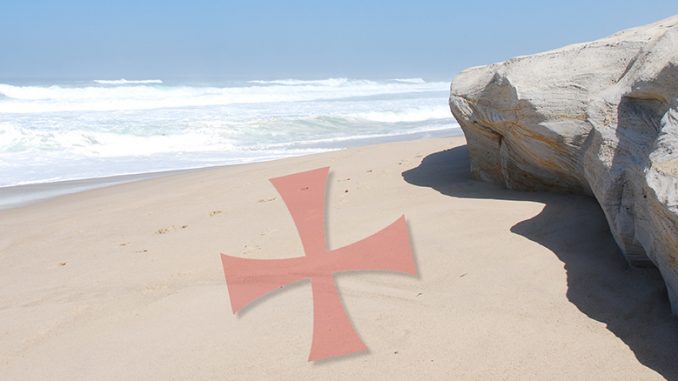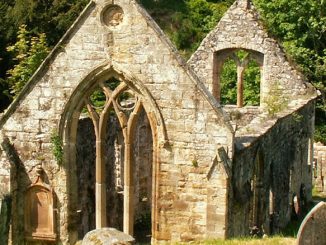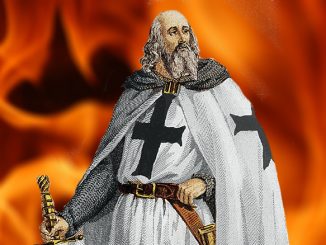
An excerpt fon the Templars in Portugal rom The Warriors and the Bankers by Alan Butler and Stephen Dafoe
Many who have read accounts of how Templars, fleeing the French oppression of 1307, set the fleet towards Portugal where they joined the newly formed “Order of Christ” are left with the impression that the “Order of Christ” had been established with the express objective of offering sanctuary to the Templars. In reality the Knights Templar had already held a strong presence in the Iberian Peninsula for many years prior to 1307 and the arrest of the French brethren.
In 1128, just one year after the order received its rule at the Council of Troyes, Teresa of Portugal gave the newly formed knights the town of Fonte Arcada. This gift was not entirely altruistic or as compensation for Portugal being unwilling to take up the Crusaders cross. For the Templars there was indeed a price to be paid which was to help win back territories previously occupied by the Moors. This, the brethren did with the zeal and military skill that has become synonymous with the warrior monks.
From the period of 1143-1190, the Knights Templar presence in Portugal became stronger by the year. The castle of Langrovia was donated by Fernao Mendes and his wife the Infanta Sancha Henrique, who was the sister of King Henrique, and with whom Templars had worked in previous times. Later in 1159, the order was granted Castle Ceras, which was, at the time, little more than a ruin. The Portuguese Templar Master, Gualdim Pais decided to construct a new fortress in the area, which he commenced one year later in 1160. This fortress was to be built in nearby Tomar. This particular piece of Templar architecture survives to this day and is not only a principle tourist attraction in Portugal, but is considered by many to be both a mystical and spiritual place.
The castle itself is known by the name, “Convento de Cristo” and remains an impressive epitaph to Templar abilities in architecture. Within its ancient fortifications lies an eight sided chapel, which was a standard style of Templar architecture. This octagonal form of building which the Templars are believed to have developed from the Muslim’s “Dome of the Rock” in Jerusalem, served a threefold objective to the Templar masons. Firstly its eight walls formed a superior edifice of structural stability. Secondly it called to mind the overall shape of the Templar Cross Patee, which can be easily formed within the confines of the octagon. Finally, the octagon, especially when combined within the circle, formed a sacred geometry associated with Gnostic beliefs, for which the Knights Templar were said to share an affinity. It is rumored that within this octagonal chapel, called a “Charola”, neophyte Templar knights were initiated on horseback.
Another related mystical Templar holding is close to Tomar. This is the Church of Santa Maria do Olivel, considered by the Portuguese to be the Mother Church of all the churches in Africa, Asia and even the America’s. Its most striking aspect is the large window on its front facade adorned with a rosette containing the Templar Sigil. At Santa Maria do Olivel is buried the body of Master Gauldim Pais, who founded Tomar as a Templar province. But Tomar would not be the end of the Templar expansion in Portugal. Nine years later the order was allowed to retain a full third of all lands captured south of the Tagus. During this period it was confirmed that the Portuguese Templars owned the castles of Tomar, Cardiga and Foz do Zezere. In reality the ownership of these locations would prove to be a moot point in 1314, when King Dinis would claim them for himself.
In general, the Portuguese Templar position continued to grow and remain stable throughout the reigns of Afonso I and II, right on to that of King Sancho III. It was not until the reign of Afonso III, that the Templars began to carry less favor in the eyes of the Portuguese Monarchy. The reasons for this decline in esteem are sketchy at best and not particularly pertinent to our story, and in any case it was a later Portuguese king who would prove pivotal during the true decline of the Templars in 1307.
This monarch was King Dinis I (1279-1325) who achieved much on behalf of his country. Dinis’ promotion of agriculture earned him the name, “The Farmer”, while his love of literature, especially poetry, of which he is said to have written volumes, was perhaps his reason for establishing a university at Lisbon. Dinis was instrumental in the growth of industry within Portugal forming a commercial treaty with King Edward I of England in 1294. Politically, Dinis was perhaps most noted for his work against the military orders, especially the order of Santiago, which, within his territory, he was able to bring under Portuguese control. It was this same spirit that would work to his advantage during the persecution of the Templars by Philip Le Bel and Clement V.
The above article on the Templars in Portugal is a reprinting of a chapter of “The Warriors and Bankers” and is © 1998 by Alan Butler and Stephen Dafoe. It is not to be distributed in any fashion without the express written permission of the authors or the publisher Lewis Masonic.
About Us
We hope you enjoyed this article ont he Templars in Portugal.
TemplarHistory.com was started in the fall of 1997 by Stephen Dafoe, a Canadian author who has written several books on the Templars and related subjects.
Read more from our Templar History Archives – Templar History



